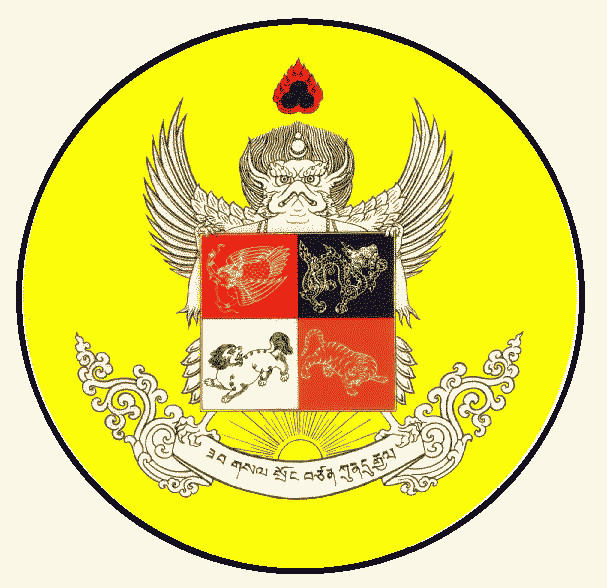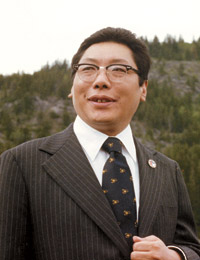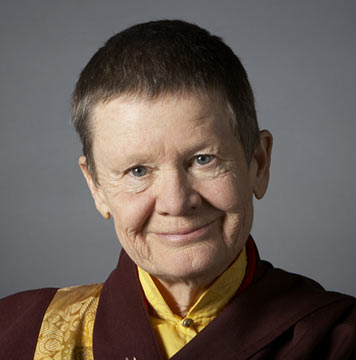Shambhala Lineage

Shambhala Meditation Center of Los Angeles is part of Shambhala, a global social movement to bring kindness, insight, meditation, and sacredness into society.
What is Shambhala?
The Shambhala tradition believes in what it calls Basic Goodness: the inherent wisdom, compassion, and courage of all beings, and even of human society. It believes this is our fundamental nature. It acknowledges our inherent human dignity, worthiness, completeness and non-faultiness, and leads us to have confidence in that. These can be the foundational principles for society. They are the potential for enlightened society. In this tradition enlightened society is not a Utopian state, but it is a society that has enough confidence and trust to acknowledge humanities most innate principle: basic goodness.
The tradition holds that these principles do not belong to one culture or religion. This is a secular non-religious approach that teaches the way to cultivate courage, dignity, and kindness, and therefore a good human society. The Shambhala tradition holds that these noble qualities are inherent in all beings and are ultimately more stable than aggression and greed.
“Shambhala” is the name of a mythical kingdom in Central Asia where the people enjoyed harmony, good health, and well-being. The basis for such an enlightened society is the people’s confidence and respect for inherent goodness, wisdom and dignity–in themselves, in each other, and in society. The wisdom that enabled the culture and community of Shambhala to flourish has been handed down from teacher to student, and is the core of Shambhala’s offerings. The kingdom of Shambhala is a model for the creation of enlightened society here and now.
Shambhala Teachings
The teachings are grounded in ancient wisdom and practical knowledge from many traditional cultures, especially teachings from ancient Tibet. These teachings begin with the understanding that all beings are basically good, and that life is worth living. We call this a path of spiritual warriorship, which here means living a life of fearlessness, gentleness, and intelligence. The Shambhala teachings emphasize being in the world, and bringing together everyday life, work, family, and social action with the path of meditation. The teachings focus on how to help this world. In essence, Shambhala is about living a full human life, right in the midst of challenges.
“The Shambhala teachings are founded on the premise that there is basic human wisdom that can help to solve the world’s problems. The wisdom does not belong to any one culture or religion, nor does it come from the West or the East. Rather, it is a tradition of human warriorship that has existed in many cultures at many times throughout history.”
— Chögyam Trungpa Rinpoche, Shambhala: The Sacred Path of the Warrior
The Shambhala Path
Discovering one’s own innate goodness and the goodness in society
 It is the Shambhala view that every human being has a fundamental nature of goodness, warmth and intelligence. This nature can be cultivated through meditation, following ancient principles, and it can be further developed in daily life, so that it radiates out to family, friends, community and society. In the course of our lives, this goodness, warmth and intelligence can easily become covered over by doubt, fear and egotism. The journey of becoming fully human means seeing through fear and egotism, and waking up to our natural intelligence. It takes kindness–to ourselves and others–and courage, to wake up in this world.
It is the Shambhala view that every human being has a fundamental nature of goodness, warmth and intelligence. This nature can be cultivated through meditation, following ancient principles, and it can be further developed in daily life, so that it radiates out to family, friends, community and society. In the course of our lives, this goodness, warmth and intelligence can easily become covered over by doubt, fear and egotism. The journey of becoming fully human means seeing through fear and egotism, and waking up to our natural intelligence. It takes kindness–to ourselves and others–and courage, to wake up in this world.
The journey of awakening is known as the path of the warrior, as it requires the simple bravery to look directly at one’s s own mind and heart. The essential tool for doing this is mindfulness meditation. As we continue on the Shambhala path, we learn many other practices, to help us break through the ancient crust of ego and awaken to the joy of fully living in this world. Awakening and opening, we discover the world to be naturally sacred, pure and full of beauty. We begin to see clearly the goodness and wisdom of others, and to feel compassion to help them in myriad ways.
Shambhala vision is rooted in the contemplative teachings of Buddhism, yet is a fresh expression of the spiritual journey for our time; it is available to practitioners of any tradition. Our lineage draws on the wisdom of the Kagyu and Nyingma schools of Tibetan Buddhism, as inherited by founder of Shambhala, Chögyam Trungpa Rinpoche, and his son and spiritual heir, Sakyong Mipham. In the mid-1970’s Chögyam Trungpa Rinpoche began to introduce teachings on Shambhala vision, based on his encounter with the Western world, and on the specific wisdom imparted from the Buddha to King Dawa Sangpo, the first sovereign of the legendary kingdom of Shambhala. This tradition teaches how to live in the secular world with courage and compassion.
“In essence, the emphasis of the Buddhist path is to help us attain enlightenment, and the emphasis of the Shambhala path is help us create and maintain a good society. When we put these two together, we have the Shambhalian Buddhist view of enlightened society.”
– Sakyong Mipham Rinpoche, Shambhala Lineage Holder. Learn more about the Shambhala lineage
![]()
LINEAGE HOLDER
Sakyong Mipham Rinpoche
 Sakyong Mipham Rinpoche is the head of the Shambhala Buddhist lineage, a spiritual and family lineage that descends through his family, the Mukpo clan. This tradition emphasizes the basic goodness of all beings and teaches the art of courageous warriorship based on wisdom and compassion.
Sakyong Mipham Rinpoche is the head of the Shambhala Buddhist lineage, a spiritual and family lineage that descends through his family, the Mukpo clan. This tradition emphasizes the basic goodness of all beings and teaches the art of courageous warriorship based on wisdom and compassion.
Rinpoche is the son and heir of the Vidyadhara, the Venerable Chögyam Trungpa Rinpoche. His background embraces both Eastern and Western cultures. Born in 1962 in Bodhagaya, India, he received spiritual training from his father and other distinguished lamas and received further education and training in Europe and North America. He is married to Khandro Tseyang Palmo, daughter of His Eminence Namkha Drimed Rabjam Rinpoche, head of the Ripa lineage. They have three daughters.
The Sakyong has written a number of books, including the national bestseller Turning the Mind into An Ally, the prize-winning Ruling Your World, The Shambhala Principle and Running with the Mind of Meditation. He is a poet and an artist. He has run marathons to raise money for Tibet through the Konchok Foundation. He travels extensively, teaching throughout the world. Learn more at www.sakyong.com. See also this YouTube Channel for video of teachings and interviews.
A video interview with Sakyong Mipham from The New Yorker
“When we talk about enlightened society, we aren’t talking about some utopia where everyone’s enlightened. We’re talking about a culture of human beings who know the awakened nature of basic goodness and invoke its energy in order to courageously extend themselves to others.”
FOUNDER
Vidyadhara Chögyam Trungpa Rinpoche

Chögyam Trungpa Rinpoche was one of the most dynamic teachers of Buddhism in the 20th Century. He was a pioneer in bringing the Buddhist teachings of Tibet to the West and is credited with introducing many Buddhist concepts into the English language and psyche in a fresh and new way.
Chögyam Trungpa Rinpoche, the former supreme abbot of Surmang Monasteries in Tibet, was known as the foremost meditation master and teacher of Tibetan Buddhism in the West. In the early 1970s, he founded Naropa University, the first Buddhist-inspired university in North America, along with over 100 meditation centers worldwide. He authored two dozen books on meditation, poetry, art, and the Shambhala path of warriorship.
“The Buddhist tradition teaches the truth of impermanence, or the transitory nature of things. The past is gone and the future has not yet happened, so we work with what is here — the present situation. This actually helps us not to categorize or theorize. A fresh, living situation is taking place all the time, on the spot. This non-categorical approach comes from being fully here, rather than trying to reconnect with past events. We don’t have to look back to the past in order to see what people are made out of. Human beings speak for themselves, on the spot.”
Read Chögyam Trungpa Rinpoche’s biography on the Shambhala International website.
SHAMBHALA TEACHERS
Acharya Pema Chödrön

Pema Chödrön is an American Buddhist nun, resident teacher at Gampo Abbey, and the author of such popular books as The Places That Scare You, When Things Fall Apart and Start Where You Are. Her life experiences as wife, mother, and school teacher, and her years of study and practice with Chögyam Trungpa Rinpoche uniquely empower Pema to speak to Westerners, both Buddhists and non-Buddhists.
“Welcome the present moment as if you had invited it. It is all we ever have so we might as well work with it rather than struggling against it. We might as well make it our friend and teacher rather than our enemy.”
– Pema Chödrön
See also Pema’s website
Acharyas (Senior Teachers)
The acharyas of Shambhala are senior teachers appointed by Sakyong Mipham Rinpoche. As the Sakyong’s representatives, the acharyas, who are empowered to offer refuge and bodhisattva vows, bring the continuity of the lineage into the living teaching environment of local Shambhala centers.
Sakyong Mipham Rinpoche chose these individuals because of their knowledge, wisdom, and commitment to the confluence of teachings found in Shambhala.
Shastri
In Sanskrit, shastri literally means “teacher learned in the texts and commentaries”. The shastris have been appointed for three year terms by Sakyong Mipham Rinpoche to bring the current understanding of the Shambhala Buddhist vision and teachings to their centers, to be a reference point for questions about the path, and in particular to help establish The Way of Shambhala curriculum as the core path. A major role of the shastri is to personally mentor and strengthen the local teaching mandala. Shastris will also support the leadership in Shambhala centers in building community and strengthening the vision of enlightened society.
Shambhala Los Angeles currently has four local shastris: Pamela Bothwell, Marcy Fink, Marilyn Moore and Joel Wachbrit.
http://youtu.be/AsQRRbW_W8E

